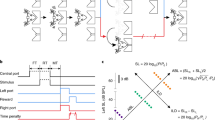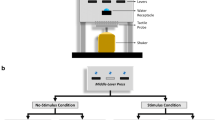Summary
-
(1)
The withdrawal response of the land snail helix albolabris disappears on appropriate repetition of the (mechanical) stimulus. In the usual terminology, the snail becomes habituated to the stimulus.
-
(2)
The disappearance of the response cannot be due to fatigue, as this term is usually understood; for (a) a single stimulus may be sufficient to effect it, (b) more intense stimulation will, under conditions not quantitatively ascertained, remove the habituation, a fact difficult to reconcile with the ordinary conception of fatigue, (c) cases were observed where the habituation took longer to re-effect after the extraneous stimulus than before.
-
(3)
Habituation disappears after appropriate rest. It may be deepened by further stimulation after response has ceased.
-
(4)
The hypothesis is put forward of a physiological state or process tending to diminish action; such process would be intensified by appropriate repetition of the existing stimulus, and diminished by appropriate rest and extraneous stimulation. A similar hypothesis is made to explain the “extinction” of conditioned responses by Pavlov, who calls the underlying process ‘Inhibition’. The phenomenon investigated, and “extinction” of conditioned reflexes probably have the same explanation.
-
(5)
With reference to the phenomena of habituation, the snail, as a biological system, behaves in the manner that would be expected of a system obeying Le Chatelier's rule.
Similar content being viewed by others
References
Beritoff, J. S., On the Fundamental Processes in the Cortex of the Cerebral Hemispheres. Brain, 47, p. 358, 1924.
Dodge, Raymond, Elementary Conditions of Human Variability, New York, Columbia University, sections 3 and 4.
Washburn, M. F., The Animal Mind. New York, 1926, pp. 251 seq.
Pavlov, I. P., Conditioned Reflexes, London 1927. Lecture 23, Cf. Lecture 4.
Sherrington, C. S., Integrative Action of the Nervous System. New Haven, 1923, pp. 214 et seq.
Kinoshita, T., Über den Einfluß mehrerer aufeinanderfolgender wirksamer Reize auf den Ablauf der Reaktionsbewegungen bei Wirbellosen. Arch. f. Physiol. 134, 501, 140, 167.
Pavlov, 1927. Lecture 4.
Cohen, L. H., Relationship between Refractory Phase and Negative Adaptation in Reflex Response. J. Comp. Psych. 9, p. 1, 1929.
Washburn, E. W., Principles of Physical Chemistry, New York, 1921, pp. 359, 360.
Rignano, E., Psychology of Reasoning. London 1923, pp. 6, 7.
Adrian, E., The Basis ot Sensation. London 1928.
Le Chatelier, H. L., Les Equilibres chimiques. Paris 1885, p. 207.
Author information
Authors and Affiliations
Rights and permissions
About this article
Cite this article
Humphrey, G. Le Chatelier's rule, and the problem of habituation and dehabituation in helix albolabris. Psychol. Forsch. 13, 113–127 (1930). https://doi.org/10.1007/BF00406763
Received:
Published:
Issue Date:
DOI: https://doi.org/10.1007/BF00406763




